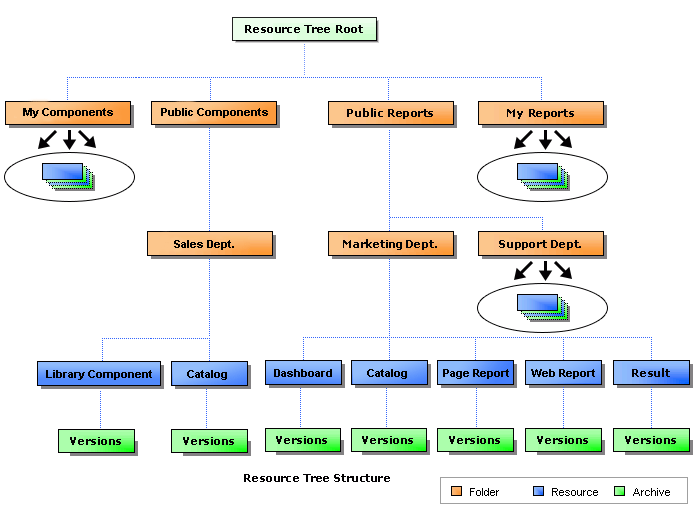

JReport Server provides a resource system for managing a group of archive versions that can be processed or organized.
Generally, a resource refers to report or dashboard related material. To be exact, a resource in the JReport Server reporting system is a conceptual node. There are different types of resources, such as catalogs, reports, dashboards, library components, and their results. A resource can only hold versions of the same type.
All the resources are organized in a folder-tree structure. JReport Server defines an XML file called admin.xml, and the resource tree conforms to this file. This file is maintained automatically by JReport Server.
For example, your company has two departments - Support and Marketing. Each department has its reports on their own machine. There are some report documents that are submitted by the departments located on the machine where JReport Server runs. Now, suppose you are the administrator, and you would like to organize these files and folders into the Resource Tree. The following diagram may help you to figure out the framework on which you should build the resource tree.

The resource tree consists of the following three layers:
Public Reports and My Report are two built-in folders in the resource tree root for storing resources such as reports, dashboards and Visual Analysis templates. You can create your own folders in either of them. The Public Reports folder and the My Reports folder cannot be deleted.
The Public Reports folder contains public resources, and can be accessed by everyone.
The My Reports folder is a personal folder. It contains personal resources. Each user has one personal folder, specified by the administrator when the user account is created. The My Reports folder can only be accessed by its owner, and the user has full control over his/her personal folder. This folder is the default output location for resources run by the user.
Reports
There are two types of reports in JReport: page reports and web reports. A page report is a collection of report tabs and each report tab can have multiple pages, while a web report has no report tabs and is always displayed as a web layout report with just one page.
JReport Server supports viewing, advanced running and scheduling of reports. The background run/scheduled/active/completed record are based on report level.
On JReport Server, you can also create page reports with Page Report Studio and web reports with Web Report Studio.
Dashboards
Dashboards, created using JDashboard, allow you to see the big picture by comparing charts, tables, and other components side-by-side.
Visual Analysis templates
Visual Analysis templates are the data status saved via Visual Analysis.
Public Components and My Components are two built-in folders in the resource tree root for storing library components. Their behaviors resemble the Public Reports and My Reports folders.
The Public Components folder contains public components and can be accessed by everyone. The My Components folder is a personal folder that contains personal components for each dashboard user.
Library components
Library components are used to build dashboards. They are able to present data via intuitive components such as charts, crosstabs, tables, and geographic maps. Library components are created and edited using JReport Designer, and then are published to the component library on JReport Server for use in dashboards.